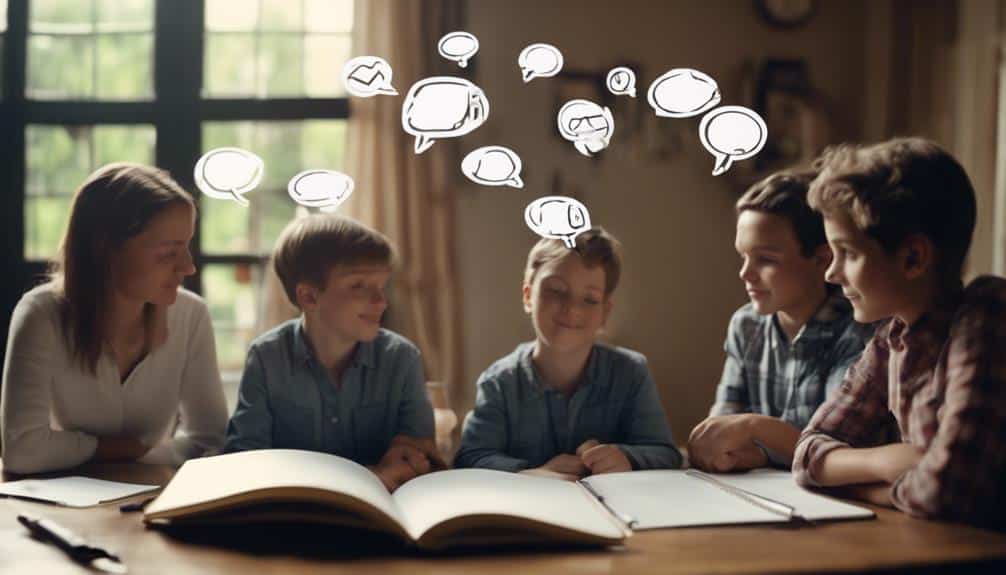When your child has a meltdown, approach them calmly and patiently, creating a safe and peaceful environment for their recovery. Offer immediate reassurances of your support and understanding, which is vital in guiding them from meltdowns to mindfulness. Ensure physical safety by removing hazards and providing a quiet space for them to regain composure, fostering their journey towards mindfulness.
Engage in comforting gestures and calming activities, such as relaxation techniques or sensory play, to help them transition from meltdowns to mindfulness. Discuss the meltdown respectfully, acknowledging their feelings and encouraging open communication, facilitating their path towards mindfulness. Identify triggers, teach self-regulation and pivotal steps in preventing future incidents, and foster mindfulness in your child.
This nurturing approach not only aids in recovery but also strengthens your bond and resilience as a family, uncovering deeper insights along the way toward mindfulness.
Key Takeaways
- Approach the child calmly, ensuring a safe and peaceful environment for recovery.
- Offer comfort and reassurance, utilizing soothing tones and gestures.
- Engage in calming activities like relaxation techniques or quiet reading to help the child regain composure.
- Discuss the meltdown respectfully, using age-appropriate language to explore feelings and triggers.
- Identify triggers and needs, observing patterns to prevent future meltdowns through proactive planning and communication.
Meltdown to Mindfulness: Assess the Situation
When a child experiences a meltdown, the immediate priority is to assess the situation with compassion and understanding, ensuring the safety and well-being of all involved. In these moments, it becomes critical to approach the child with a reassuring presence, acknowledging their feelings without judgment. Offering a gentle voice and open arms can be the first step towards making the child feel supported and cared for, which is essential in initiating the calming process.
Creating a safe space for your child to calm down is vital for post-meltdown recovery. This involves identifying where the child can retreat from stimuli that may have triggered the meltdown, allowing them to process their emotions without additional stress. Maintaining a calm and peaceful atmosphere not only aids in recovery but also reinforces a sense of security and belonging.
As the child begins to calm down, it’s essential to remain patient and available when they’re ready to reengage. Each child’s recovery process will vary, and being mindful of their emotional state and readiness can help plan the next re-engagement steps. The emphasis on creating a nurturing environment post-meltdown is paramount in supporting the child’s journey back to calmness and equilibrium.
Ensure a Safe Environment
After evaluating the situation and reassuring your child, the following vital action is ensuring the environment around them is secure and favorable for recovery. Creating a safe environment is essential to help your child navigate their feelings and begin the process of healing after a meltdown. This involves both physical safety and psychological security, ensuring that your child feels supported and understood.
| Strategy | Purpose |
|---|---|
| Remove potential hazards | To prevent the risk of injury, ensure your child’s physical safety during recovery. |
| Create a calm, quiet space. | To minimize stimuli that could trigger further distress, offering a serene environment. |
| Offer a comforting retreat. | To provide a dedicated space for relaxation and recovery, reinforcing a sense of security. |
| Maintain a patient demeanor. | To help your child feel loved and supported, fostering a trusting and secure recovery atmosphere. |
Provide Comfort and Reassurance

After a child’s meltdown, it is vital to provide comfort and reassurance, aiming to restore their sense of security and trust. Identifying triggers can empower parents to prevent future episodes while teaching calming techniques offers children valuable tools for self-regulation. Establishing a safe space where a child feels understood and supported lays the foundation for healing and strengthens the parent-child bond.
Identifying Emotional Triggers
Understanding the underlying feelings and triggers that lead to a child’s meltdown is vital in providing them with the comfort and reassurance they need to feel supported and secure. Whether they stem from sensory overload or unmet needs, triggering factors are essential to ponder when meltdowns happen. By recognizing and addressing these triggers, parents can help their child feel understood and work towards preventing future episodes.
Providing a child with your love and care, particularly after a meltdown, aids in their emotional recovery and fosters a sense of security. Creating a safe and calm environment is fundamental in helping the child navigate their feelings, ultimately supporting their journey towards emotional regulation and resilience.
Techniques for Calming Down
After a child experiences a meltdown, employing specific techniques to calm them down can significantly aid their mood regulation. This offers the comfort and reassurance they need to feel secure and supported. Providing this comfort is crucial in creating a sense of safety, which is vital for their mental recovery. Reassuring your child of your unwavering love and support helps them navigate the tumultuous waters of their feelings.
Physical gestures like hugs or gentle pats can be incredibly soothing, making them feel calm and secure. Additionally, speaking softly and soothingly conveys understanding and support, fostering a peaceful environment that promotes relaxation. These measures are not just acts of kindness but are foundational steps toward helping your child achieve mental recovery after a meltdown.
Establishing a Safe Space
Establishing a safe space provides the next layer of support, building on the foundation of calming techniques and offering your child a tranquil environment where comfort and reassurance are readily available. This secure area, free from sensory triggers, becomes a sanctuary for your child to calm down, enveloped in comfort. Staying close by, you offer physical safety and a comforting presence, communicating understanding and support.
| Sensory Element | Comforting Aid |
|---|---|
| Visual | Dim lights |
| Auditory | Soft music |
| Tactile | Cozy blankets |
| Expressive | Your presence |
| Cognitive | Favorite toys |
Engage in Calming Activities

Engaging in calming activities, such as deep breathing or listening to soothing music, can play an essential role in helping your child find relaxation and comfort after experiencing a meltdown. These methods not only soothe the nervous system but also promote a sense of safety and belonging, which is vital for your child’s emotional recovery.
Incorporating sensory activities, like playing with kinetic sand or snuggling under a weighted blanket, offers distinct pathways to calmness, catering to your child’s personal needs for sensory input. Such activities are not just distractions but therapeutic tools that aid in processing emotions and regaining equilibrium.
When welcomed, a hug or gentle touch can be a powerful communicator of security and love, reinforcing your child’s sense of safety and attachment. This simple gesture can notably reduce stress levels and foster a serene environment for you and your child.
Providing a quiet space for activities like reading or drawing can help your child gently shift from a state of upheaval to tranquility. In addition, introducing mindfulness techniques such as guided imagery or progressive muscle relaxation can equip your child with valuable skills to manage stress and navigate future meltdowns with greater ease and resilience.
Discuss the Meltdown Respectfully
Attending to your child’s inner turmoil with understanding and compassion is crucial to healing after a breakdown. Acknowledging your child’s feelings and emotions demonstrates that you care and fosters a sense of security. Discussing the meltdown respectfully is essential, guaranteeing that your child feels heard and understood. This respectful dialogue can pave the way for open communication, allowing both parent and child to explore solutions together. Using age-appropriate language and maintaining a calm demeanor are vital in facilitating a constructive conversation.
| Strategy | Benefit |
|---|---|
| Acknowledge feelings and emotions | Builds trust and shows empathy |
| Discuss meltdown calmly and respectfully | It helps process the experience positively |
| Encourage open communication | Fosters a collaborative approach to problem-solving |
| Use age-appropriate language and tone | Ensures clarity and maintains a supportive atmosphere |
Offering reassurance and support is paramount, as it reminds your child they are not alone. You can help your child navigate their emotions through these efforts, turning a challenging meltdown episode into a valuable learning experience.
Identify Triggers and Needs

Understanding the specific triggers and underlying needs that lead to your child’s meltdown can help prevent future episodes and foster a more supportive environment. By closely observing patterns before, during, and after the meltdown, parents can begin to identify triggers that may have contributed to the outburst. Recognizing your child’s unmet needs is essential in this process, as these are often at the heart of why meltdowns occur.
Environmental factors also play a significant role and should not be overlooked. Changes in routine or unexpected events can be incredibly destabilizing for children, leading to confusion and frustration. Keeping a detailed log or diary of these episodes can be invaluable. It allows for tracking common themes and triggers, providing a clearer understanding of what may be causing distress.
Practice Self-Care
After traversing the intense emotional terrain of your child’s meltdown, turning attention toward your well-being is crucial. You are engaging with a support network, whether friends or family or providing a valuable outlet for expressing and processing your emotions. Implementing practices like mindfulness can also help you regain your sense of calm, ensuring you’re replenished and more resilient for future challenges.
Recognize Your Feelings
Recognizing your mental state—be it frustration, stress, or exhaustion—is a critical first step in effectively managing the aftermath of your child’s meltdown. It’s essential to acknowledge your feelings and understand the importance of self-care and mental regulation during these moments. Deep breathing or mindfulness techniques can serve as a valuable tool to calm yourself before addressing the situation with your child. Taking a moment to assess your emotions allows you to prioritize self-care, ensuring you don’t escalate the situation unintentionally. Remember, maintaining a supportive and calm environment for your child’s recovery after a meltdown is paramount, and self-care is a cornerstone in achieving this goal.
Seek Support Networks
Handling the intricacies of a child’s outburst can be mentally draining, making it essential for parents to find supportive networks and participate in self-care practices that promote resilience and well-being. To navigate this journey, consider the following steps:
- Join online support groups or local parent networks to share experiences and gain psychological support after your child’s meltdown.
- Practice self-care by engaging in activities that help you relax and recharge, such as exercise, meditation, or hobbies.
- Seek professional help or counseling if you feel overwhelmed or need additional guidance in handling your child’s meltdowns.
- Connect with other parents or caregivers who understand your challenges and can offer practical advice on managing post-meltdown situations.
Develop a Family Safety Plan

Creating a family safety plan is a proactive step towards minimizing the chance of future meltdowns by addressing potential triggers and unmet needs in a supportive and understanding manner. Reflecting on what may have led to your child’s tantrums or meltdowns is crucial. It’s a journey of teaching your child and yourself about regulation and resilience.
| Strategy | Action |
|---|---|
| Reflect on triggers | Note situations or needs that preceded the meltdown. |
| Quality time | Dedicate moments for affection and connection to reassure your child. |
| Relaxation | Incorporate self-care and downtime for everyone to recharge. |
Creating this plan together as a family fosters a sense of belonging and support. It’s about preventing the next meltdown and building a nurturing environment where each member feels valued and understood. Reflection, connection, and relaxation are a cornerstone in recovering from the event and crafting a more empathetic and cohesive family unit. In doing so, you’re not just addressing the immediate aftermath but laying the groundwork for a more harmonious future.
Implement Lessons Learned
Implementing lessons learned from past meltdowns is essential in fostering a supportive and understanding environment for your child. Recognizing triggers and signs early on, establishing calming strategies tailored to your child’s needs, and encouraging open communication can reduce the intensity and frequency of future meltdowns. This proactive approach not only aids in your child’s psychological development but also strengthens the bond of trust and understanding between you and your child.
Recognize Triggers and Signs
Understanding the precursors and symptoms of a child’s meltdown involves closely observing patterns in their behavior and environment to address their needs preemptively. Recognizing triggers and signs and implementing lessons learned from previous incidents are essential to preventing future meltdowns. Here’s how:
- Identify Patterns: Notice what precedes meltdowns; is it a specific time of day, activity, or environmental factor?
- Watch for Early Signs: Increased agitation, stimming, or withdrawal can be critical indicators for intervention.
- Reflect Together: Post-meltdown, engage in a gentle discussion to understand what triggered the episode.
- Implement Strategies: Use insights gained to adjust routines, environments, and responses to better meet your child’s needs.
Establish Calming Strategies
Having identified triggers and signs, it is crucial to now focus on establishing calming strategies that can assist your child in effectively recovering from a meltdown. Implementing these strategies fosters a nurturing environment that supports post-meltdown recovery and reinforces your child’s sense of security and belonging.
| Strategy | Description |
|---|---|
| Relaxation Techniques | Use deep breathing or sensory tools to calm and reset your child’s emotions. |
| Quality Time | Reconnect through activities that reassure love and support. |
| Reflection | Discuss triggers and unmet needs to understand and mitigate future incidents. |
Embracing these strategies helps you handle tantrums or meltdowns and strengthens the bond between you and your child, ensuring a smoother recovery process and a healthier emotional future.
Foster Open Communication
Uncover communication with your child, especially after a meltdown, is essential to understanding their feeling landscape and nurturing a deeper bond. Implementing lessons learned through fostering open dialogue can profoundly impact your relationship. Here are steps to help your child and foster understanding:
- Listen actively to your child’s perspective, validating their feelings without judgment.
- Discuss triggers and emotions openly to understand the root causes of meltdowns.
- Collaborate on identifying coping strategies that could prevent future meltdowns.
- Create a preventive plan together, ensuring your child feels heard and supported.
Strengthen Communication Skills
Improving communication skills, including using clear, concise language and active listening, is essential in effectively addressing and maneuvering through the aftermath of a child’s meltdown. When tantrums occur, it’s vital to approach the situation with a blend of empathy and practical communication techniques. This means speaking clearly so your child can understand and listen intently to their responses.
By validating their feelings and showing that you genuinely care about their perspective, you create a safe space for them to express themselves.
Implementing structured conversations can significantly enhance this process. This involves setting aside a calm time to discuss what happened and using nonverbal cues like eye contact to convey your full attention and concern. Such practices help resolve the immediate issue and build a stronger foundation for future communication.
Remember, the goal is to foster an environment where your child feels heard and understood, thereby improving your relationship and making it easier to navigate similar situations in the future. By focusing on these communication skills, you can help your child learn to express their emotions healthily, strengthening the bond between you.
Plan for Future Incidents

Anticipating future incidents, families must identify patterns and triggers that lead to a child’s meltdowns, enabling them to construct a proactive and supportive strategy for prevention and management. Recognizing and addressing these triggers and unmet needs is a cornerstone in developing a tailored plan for future incidents. This plan fosters a sense of security within the family and empowers the child to feel understood and supported.
To construct a practical plan for future incidents, consider the following steps:
- Reflect on Triggers and Unmet Needs: Analyze past meltdowns to identify specific triggers and unmet needs, crafting strategies that address these directly.
- Create a Family Safety Plan: Collaboratively establish guidelines that aim to prevent future meltdowns by addressing potential triggers in a supportive manner.
- Recharge with Self-Care: Prioritize self-care for all family members to ensure mental and physical resilience, enabling a calm and composed response to future challenges.
- Reconnect through Quality Time: Spend quality time with your child, offering affection and reassurance of your unwavering love and care, reinforcing a secure attachment that can mitigate the impact of triggers.
Frequently Asked Questions
What to Do When Your Child Has a Meltdown?
When a child experiences a meltdown, it’s essential to approach the situation with empathy and patience. Reassure them, maintain a calm environment, allow them space to recover, and discuss the incident thoughtfully when appropriate.
Is It Best to Ignore a Child Having a Meltdown?
Ignoring a child during a meltdown is not advisable as it may overlook the opportunity to teach coping mechanisms. Instead, providing support and understanding post-incident fosters psychological growth and strengthens the parent-child bond.
How Do You Snap a Child Out of a Meltdown?
Sailing through a child’s feelings and storms requires a caring guide. Trying to ‘snap’ them out of a breakdown is less about sudden intervention and more about offering a secure harbor for their emotions to anchor and calm down.
How Do You End a Meltdown?
To address a child’s meltdown, it is paramount to create a serene environment, ensuring the child feels safe and supported. Offering comfort, patience, and understanding aids in gently guiding them back to a calm state.
Conclusion
Managing a child’s emotional meltdown can be challenging for parents. When your child is experiencing an emotional meltdown, staying calm and providing safety is essential. Engage in deep breathing exercises with your child to help regulate emotions. Practice mindful breathing together, making eye contact to support a sense of calm and connection. Conscious breathing can help regulate cortisol levels and promote a deeper restfulness in you and your child.
Discuss and label emotions with your child to help them understand and manage their feelings. Create a safety plan with calming tools and coping skills during emotional meltdowns. Please encourage your child to express their emotions through body language and provide a secure environment for them to learn and grow. Seek support from a pediatric occupational therapist or a mindful parenting mentor to learn practical tools for emotional regulation and behavior management.
Plan regular outings to the neighborhood park or participate in children’s classes to provide a positive outlet for your child’s energy. Offer healthy snacks and engage in creative mindfulness exercises to promote a sense of calm in daily life. Remember, supporting your child’s emotional regulation skills is a learning experience for both of you. With patience and understanding, you can help your child develop practical coping skills and create a nurturing environment for the whole family.


Recent Comments